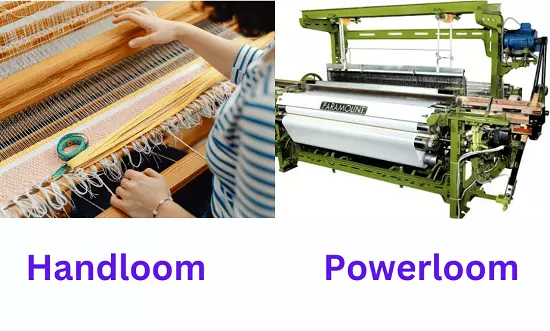Loom is a Woven Fabric Manufacturing Machine. There are two types of Loom machines; one is Handloom and another is Powerloom. Are you wondering if still handloom exists in this era? There are many significant reasons why handlooms still exist and how important it is. We are here to find out the difference between both types of looms. In this article, we described the Difference Between Handloom and Powerloom.
Handloom
Handloom refers to a traditional method of weaving fabric by hand, usually on a wooden loom. It interlacing threads to create textiles without the use of electricity, typically done in rural areas by skilled artisans. Handloom fabrics often showcase unique designs, patterns, and textures, contributing to the cultural heritage of various regions worldwide.
Powerloom
A powerloom is a mechanized version of a traditional handloom used to weave fabrics. Unlike handlooms, power looms are powered by electricity or other mechanical sources, enabling faster and more efficient production of textiles. Powerlooms automate the weaving process, allowing for larger-scale production of fabrics in a shorter amount of time compared to handloom weaving.

What is the Difference Between a Handloom and Powerloom?
While handloom and powerloom represent distinct approaches to fabric weaving, they coexist in the textile industry. Handloom fabrics hold a special place for their craftsmanship, authenticity, and cultural significance. They cater to niche markets that value traditional techniques and unique designs.
On the other hand, powerloom fabrics dominate the market due to their efficiency, cost-effectiveness, and ability to meet the demands of a larger consumer base. They cater to the mass market and ensure consistent supply for various industries.
| Handloom | Powerloom |
| Handloom is a traditional method of textile Fabric production done manually. | Power loom is a modern method of Fabric production that uses electrical machines. |
| Handloom produces high-quality fabrics. | Powerloom produces large quantities of fabrics quickly and efficiently. |
| Handloom fabrics are usually more expensive because of the manual labor involved. | Powerloom fabrics are usually less expensive because of the efficiency of the machinery. |
| Handloom fabrics are typically produced in small quantities. | Powerloom fabrics are typically produced in large quantities. |
| Handloom fabrics are typically more unique and have a distinct hand-woven look. | Powerloom fabrics have a more uniform and machine-made look. |
| Operator Efficiency and skill is the key here | Machine fitness is they for the operation |
| Less speed and less production in the process | High speed and high production in the process |
| Nowadays, Handloom is still very popular shawls, blankets, sarees, bedspreads, tablecloths, and scarves despite this is the era of power | Almost all fabric can be done in powerloom. |
Conclusion
Handloom and Powerloom represent two divergent yet complementary methods of Woven fabric production. The choice between them depends on factors like tradition, craftsmanship, scalability, production target, and market demands. Both methods contribute significantly to the rich tapestry of the textile industry, preserving heritage while adapting to contemporary needs. The appreciation of both handloom and powerloom techniques underscores the diverse and evolving nature of the textile world.
- You may love to read: Challenges Faced by Handloom Weavers: Ergonomic Perspective
